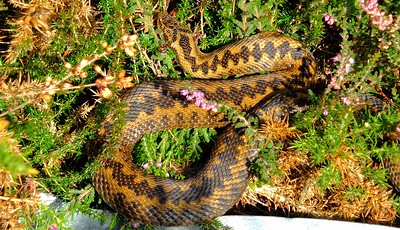
Prevent Separation Issues in Dogs
March 10, 2021
PICA in Dogs: How to identify and treat it
September 30, 2022Adder season is upon us, and dogs have already been bitten, do you know how to prevent bites, signs of a bite or what to do?
ADDER FACTS
Adders are the only venomous snake in the UK and are most seen from spring to summer. They live in open habitats such as heathland, moorland, woodland and lesser-known beach dunes in the under growth. They are usually grey or brown in colour with a dark distinctive zig-zag pattern down their back. They have a V or X shape mark on the back of their head and can be 60-80cm in length. Although they are not aggressive, they will strike when agitated or startled and their venom is incredibly toxic to animals. They are protected by the Wildlife and countryside Act 1981, so it is an offense to harm, injure, kill, trade or sell them. They hibernate from around October - February but in warmer weather, this can change. They can also live for 20 – 30 years.
DOGS MOST AT RISK
Any curious dog but puppies or young dogs may be more at risk. Dogs with a strong hunting/scenting instinct and ability as they tend to be in the undergrowth more. At certain times of day Adders might be basking in the sun, for example, on a cool morning they may be out in the sun to warm up. Risk of a bite is also increased when Adders are first coming out of hibernation.
PREVENT ADDER BITES TO YOUR DOG
Know the habitat/s you are walking in, ask local people if you are unsure as they will be able to let you know if there are Adders around. Keep to well walked paths rather than into rough ground. Train a strong recall to your dog so you can keep them out of undergrowth if you are letting them off lead. Alternatively, keep your dog on lead if you know you are in Adder habitat. Consider placing a bell onto your dogs collar, this will give Adders more warning that something is approaching.
SIGNS OF A BITE
Swelling around the bite wound is generally seen within two hours of a bite. You may see two puncture wounds within the swelling. You may notice signs of lameness, bleeding, and bruising at the wound sight. This is much harder to see in hairy dogs. The dog might just appear ‘off’ or that they have pain somewhere. Sudden vocalisation (howling, screaming) may be displayed by some dogs. The most common locations for bites are the face and front leg. This happens from sticking a face in curiously towards the snake or accidentally treading on one. Once the venom has been absorbed into the body, a widespread inflammatory response happens which might cause: vomiting, lethargy, fever, increased breathing/heart rate, increased salivation, ataxia (uncoordinated, might look drunk). In severe cases you might see: collapse, blood clotting issues, organ failure and tremors/convulsions may be possible.
WHAT TO DO IF YOUR DOG IS BITTEN
Where possible pick the dog up and carry them to the car. This might slow down the speed in which the venom travels around the body. Head straight to the vets but call them to let them know you are on your way. This will help them to prepare for your arrival. If it is out of hours you may need to head straight for the out of hours surgery. DO NOT administer any medication as this might affect what your veterinary surgeon can provide. DO NOT use a attempt to suck the venom or use restrict the blood flow. If available bath in cold water, then try to apply a cold compress to the bite site. If you are on holiday always be prepared and know the contacts of the local vets PLUS the out of hours vet as this often differs, time is crucial.
Consider purchasing an Adder Kit – it is a special type of first aid kit you can carry with you during adder season.
TREATMENT
Pain relief is usually provided as the bit and swelling can be painful. A drip may be needed to aid shock and maintain vital blood flow. Cage rest may be needed, and antihistamines may be administered. Anti-venom might be used (where available) as this makes venom inactive by binding to it, therefore ensures no further damage is caused. Anti-venom can be used in all cases but is especially useful in severe cases, however, this can be hard to obtain. Your veterinary surgeon will determine if this will be needed.
WHAT IS RECOVERY LIKE
This depends on a few factors:
⁃ How quickly veterinary treatment is administered
⁃ The bite location
⁃ Patient size (the larger the dog, the less severe they can be)
⁃ The amount and potency of the venom
⁃ Any pre-existing health issues (more at risk of becoming severe with certain underlying issues)
⁃ The amount of movement the patient does after the bite
⁃ Though signs can look severe the mortality rate is less than 5% with appropriate treatment ⁃ Average full recovery time is 5-days, but this can vary from 24 hrs to 30 days




